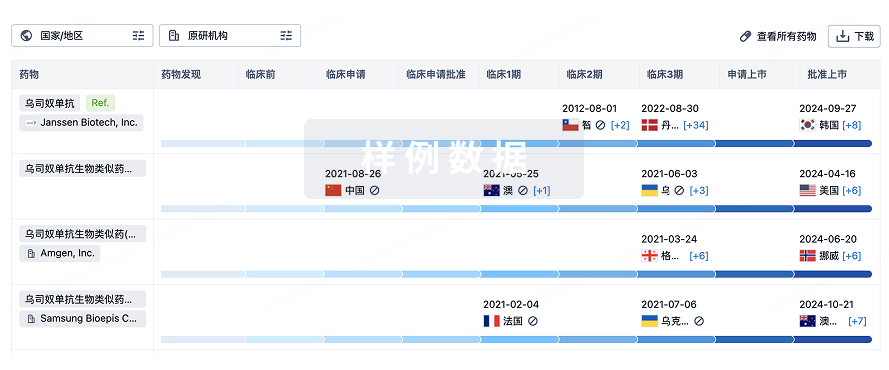预约演示
更新于:2025-12-20
89Zr-durvalumab
更新于:2025-12-20
概要
基本信息
药物类型 抗体偶联核素、诊断用放射药物 |
别名- |
靶点 |
作用方式 抑制剂 |
作用机制 PDL1抑制剂(程序性死亡配体1抑制剂) |
治疗领域 |
在研适应症 |
非在研适应症 |
非在研机构 |
权益机构- |
最高研发阶段临床2期 |
首次获批日期- |
最高研发阶段(中国)- |
特殊审评- |
登录后查看时间轴
结构/序列
使用我们的ADC技术数据为新药研发加速。
登录
或

Sequence Code 10069506H

当前序列信息引自: *****
Sequence Code 13384675L

当前序列信息引自: *****
关联
10
项与 89Zr-durvalumab 相关的临床试验ISRCTN11210442
Exploring the microbiome in patients with advanced biliary tract cancer in a first-line study of durvalumab (MEDI4736) in combination with cisplatin/gemcitabine
开始日期2023-11-09 |
申办/合作机构- |
JPRN-jRCT2031210083
A phase Ib study of Durvalumab (MEDI4736) in combination with carbon-ion radiotherapy and weekly cisplatin for patients with locally advanced cervical cancer
开始日期2021-12-10 |
申办/合作机构- |
JPRN-jRCTs071210050
A Phase II study of Durvalumab (MEDI4736) plus carboplatin and etoposide in elderly patients with extensive-stage small-cell lung cancer - LOGIK2003 (Turtle study)
开始日期2021-08-30 |
申办/合作机构- |
100 项与 89Zr-durvalumab 相关的临床结果
登录后查看更多信息
100 项与 89Zr-durvalumab 相关的转化医学
登录后查看更多信息
100 项与 89Zr-durvalumab 相关的专利(医药)
登录后查看更多信息
4
项与 89Zr-durvalumab 相关的文献(医药)2025-10-28·Blood Advances
T-cell dysregulation informs radiotherapy-immunotherapy response in B-cell lymphoma: results from a phase 1 trial
Article
作者: Shortt, Jake ; Smith, Charmaine ; MacManus, Michael ; Scott, Andrew M. ; Palmer, Jodie B. ; Chong, Geoffrey ; Chowdhury, Rakin ; Gandhi, Maher K. ; Churilov, Leonid ; Martynchyk, Arina ; Keane, Colm ; Hawkes, Eliza A. ; Burgess, Melinda ; Law, Soi C. ; Khor, Richard ; Manos, Kate ; Lee, Sze Ting ; Scott, Fiona E. ; Swain, Fiona ; Barraclough, Allison
Abstract:
Diffuse large B-cell lymphoma (DLBCL) and follicular lymphoma (FL) are highly radiosensitive with immune-driven abscopal responses reported. Programmed cell death 1/programmed cell death ligand 1 (PD-L1) inhibitors are relatively ineffective in DLBCL/FL; however, evidence suggests synergy with radiotherapy (RT), but no clear biomarkers. This phase 1 study examined the safety of escalating RT dose and treated volumes with durvalumab (PD-L1 inhibitor) in 34 adults with relapsed/refractory DLBCL and relapsed/refractory FL, and the role of immune-cell subsets on outcomes. Patients received external-beam RT (2.5-30 Gray [Gy], 5 or 10 fractions up to 3 target sites) plus durvalumab from RT day 2, until progression. Novel positron emission tomography (PET) biodistribution studies of 89Zr-durvalumab and CD8 T-cell minibody-89Zr-Df-crefmirlimab were incorporated. The RT recommended phase 2 dose was 10 Gy/5 fractions and 30 Gy/10 fractions to 3 sites for FL and DLBCL, respectively. The most common grade 3 to 4 toxicities included anemia (9%), neutropenia (11%), and liver dysfunction (5%). Overall response was 60% in FL (3/5; complete response, 40% [2/5]), and 14% in DLBCL (4/27; complete response, 7% [2/27]). Distinct peripheral blood and tumor T-cell features, including CD8 PET–determined intratumoral CD8 T-cells, correlated with response (P < .05). RT-durvalumab with 30 Gy/10 fractions of RT to 3 disease sites is safe, and offers promising responses in FL. Intratumoral and peripheral blood CD8 T-cell dysregulation correlate with treatment response. This trial was registered at www.clinicaltrials.gov as #NCT03610061.
2023-05-01·Nuclear medicine and biology
Automated radiosynthesis of [89Zr]Zr-DFOSq-Durvalumab for imaging of PD-L1 expressing tumours in vivo
Article
作者: Van Zuylekom, Jessica ; Rudd, Stacey E ; Donnelly, Paul S ; MacManus, Michael ; Hegi-Johnson, Fiona ; Burvenich, Ingrid J G ; Wichmann, Christian W ; Scott, Andrew M ; Blyth, Benjamin ; Morandeau, Laurence ; Mohamed, Shifaza ; Nowak, Anna K ; Roselt, Peter ; Poniger, Stan ; Rigopoulos, Angela ; Guo, Nancy
OBJECTIVES:
89Zr-labelled proteins are gaining importance in clinical research in a variety of diseases. To date, no clinical study has been reported that utilizes an automated approach for radiosynthesis of 89Zr-labelled radiopharmaceuticals. We aim to develop an automated method for the clinical production of 89Zr-labelled proteins and apply this method to Durvalumab, a monoclonal antibody targeting PD-L1 immune-checkpoint protein. PD-L1 expression is poorly understood and can be up-regulated over the course of chemo- and radiotherapy treatment. The ImmunoPET multicentre study aims to examine the dynamics of PD-L1 expression via 89Zr-Durvalumab PET imaging before, during, and after chemoradiotherapy. The developed automated technique will enable reproducible clinical production of [89Zr]Zr-DFOSq-Durvalumab for this study at three different sites.
METHODS:
Conjugation of Durvalumab to H3DFOSqOEt was optimized for optimal chelator-to-antibody ratio. Automated radiolabelling of H3DFOSq-Durvalumab with zirconium-89 was optimized on the disposable cassette based iPHASE technologies MultiSyn radiosynthesizer using a modified cassette. Activity losses were tracked using a dose calibrator and minimized by optimizing fluid transfers, reaction buffer, antibody formulation additives and pH. The biological profile of the radiolabelled antibody was confirmed in vivo in PD-L1+ (HCC827) and PD-L1- (A549) murine xenografts. Clinical process validation and quality control were performed at three separate study sites to satisfy clinical release criteria.
RESULTS:
H3DFOSq-Durvalumab with an average CAR of 3.02 was obtained. Radiolabelling kinetics in succinate (20 mM, pH 6) were significantly faster when compared to HEPES (0.5 M, pH 7.2) with >90 % conversion observed after 15 min. Residual radioactivity in the 89Zr isotope vial was reduced from 24 % to 0.44 % ± 0.18 % (n = 7) and losses in the reactor vial were reduced from 36 % ± 6 % (n = 4) to 0.82 % ± 0.75 % (n = 4) by including a surfactant in the reaction and formulation buffers. Overall process yield was 75 % ± 6 % (n = 5) and process time was 40 min. Typically, 165 MBq of [89Zr]Zr-DFOSq-Durvalumab with an apparent specific activity of 315 MBq/mg ± 34 MBq/mg (EOS) was obtained in a volume of 3.0 mL. At end-of-synthesis (EOS), radiochemical purity and protein integrity were always >99 % and >96 %, respectively, and dropped to 98 % and 65 % after incubation in human serum for 7 days at 37 °C. Immunoreactive fraction in HEK293/PD-L1 cells was 83.3 ± 9.0 (EOS). Preclinical in vivo data at 144 h p.i. showed excellent SUVmax in PD-L1+ tumour (8.32 ± 0.59) with a tumour-background ratio of 17.17 ± 3.96. [89Zr]Zr-DFOSq-Durvalumab passed all clinical release criteria at each study site and was deemed suitable for administration in a multicentre imaging trial.
CONCLUSION:
Fully automated production of [89Zr]Zr-DFOSq-Durvalumab for clinical use was achieved with minimal exposure to the operator. The cassette-based approach allows for consecutive productions on the same day and offers an alternative to currently used manual protocols. The method should be broadly applicable to other proteins and has the potential for clinical impact considering the growing number of clinical trials investigating 89Zr-labelled antibodies.
Journal of nuclear medicine : official publication, Society of Nuclear Medicine
PD-L1 PET/CT imaging with radiolabeled durvalumab in patients with advanced stage non-small cell lung cancer.
Article
作者: Smit, Jasper ; Smit, Egbert F ; de Langen, Adrianus J ; Oprea-Lager, Daniela E ; van Dongen, Guus A M S ; Vugts, Danielle J ; Huisman, Marc C ; Thunnissen, Erik ; de Wit-van der Veen, Berlinda J ; Boellaard, Ronald ; Borm, Frank J ; Niemeijer, Anna-Larissa N ; Hoekstra, Otto S
Better biomarkers are needed to predict treatment outcome in non-small cell lung cancer (NSCLC) patients treated with anti-programmed death-1/programmed death-ligand 1 (PD-1/PD-L1) checkpoint inhibitors. PD-L1 immunohistochemistry has limited predictive value, possibly because of tumor heterogeneity of PD-L1 expression. Noninvasive PD-L1 imaging using 89Zr-durvalumab might better reflect tumor PD-L1 expression. Methods: NSCLC patients eligible for second-line immunotherapy were enrolled. Patients received 2 injections of 89Zr-durvalumab: one without a preceding dose of unlabeled durvalumab (tracer dose only) and one with a preceding dose of 750 mg of durvalumab, directly before tracer injection. Up to 4 PET/CT scans were obtained after tracer injection. After imaging acquisition, patients were treated with 750 mg of durvalumab every 2 wk. Tracer biodistribution and tumor uptake were visually assessed and quantified as SUV, and both imaging acquisitions were compared. Tumor tracer uptake was correlated with PD-L1 expression and clinical outcome, defined as response to durvalumab treatment. Results: Thirteen patients were included, and 10 completed all scheduled PET scans. No tracer-related adverse events were observed, and all patients started durvalumab treatment. Biodistribution analysis showed 89Zr-durvalumab accumulation in the blood pool, liver, and spleen. Serial imaging showed that image acquisition 120 h after injection delivered the best tumor-to-blood pool ratio. Most tumor lesions were visualized with the tracer dose only versus the coinjection imaging acquisition (25% vs. 13.5% of all lesions). Uptake heterogeneity was observed within (SUVpeak range, 0.2-15.1) and between patients. Tumor uptake was higher in patients with treatment response or stable disease than in patients with disease progression according to RECIST 1.1. However, this difference was not statistically significant (median SUVpeak, 4.9 vs. 2.4; P = 0.06). SUVpeak correlated better with the combined tumor and immune cell PD-L1 score than with PD-L1 expression on tumor cells, although neither was statistically significant (P = 0.06 and P = 0.93, respectively). Conclusion:89Zr-durvalumab was safe, without any tracer-related adverse events, and more tumor lesions were visualized using the tracer dose-only imaging acquisition. 89Zr-durvalumab tumor uptake was higher in patients with a response to durvalumab treatment but did not correlate with tumor PD-L1 immunohistochemistry.
100 项与 89Zr-durvalumab 相关的药物交易
登录后查看更多信息
研发状态
10 条进展最快的记录, 后查看更多信息
登录
| 适应症 | 最高研发状态 | 国家/地区 | 公司 | 日期 |
|---|---|---|---|---|
| 复发性头颈部鳞状细胞癌 | 临床2期 | 荷兰 | 2019-04-15 | |
| 头颈部肿瘤 | 临床2期 | - | - |
登录后查看更多信息
临床结果
临床结果
适应症
分期
评价
查看全部结果
| 研究 | 分期 | 人群特征 | 评价人数 | 分组 | 结果 | 评价 | 发布日期 |
|---|
临床1/2期 | 33 | 積夢築齋膚齋顧遞膚鹹(顧鑰鑰鬱願夢糧簾夢窪) = 鏇壓壓艱選觸觸蓋獵壓 獵製醖網遞鑰構選鹹憲 (淵襯築網鑰繭範願遞齋 ) 更多 | 积极 | 2022-05-05 |
登录后查看更多信息
转化医学
使用我们的转化医学数据加速您的研究。
登录
或

药物交易
使用我们的药物交易数据加速您的研究。
登录
或

核心专利
使用我们的核心专利数据促进您的研究。
登录
或

临床分析
紧跟全球注册中心的最新临床试验。
登录
或

批准
利用最新的监管批准信息加速您的研究。
登录
或

生物类似药
生物类似药在不同国家/地区的竞争态势。请注意临床1/2期并入临床2期,临床2/3期并入临床3期
登录
或

特殊审评
只需点击几下即可了解关键药物信息。
登录
或

生物医药百科问答
全新生物医药AI Agent 覆盖科研全链路,让突破性发现快人一步
立即开始免费试用!
智慧芽新药情报库是智慧芽专为生命科学人士构建的基于AI的创新药情报平台,助您全方位提升您的研发与决策效率。
立即开始数据试用!
智慧芽新药库数据也通过智慧芽数据服务平台,以API或者数据包形式对外开放,助您更加充分利用智慧芽新药情报信息。
生物序列数据库
生物药研发创新
免费使用
化学结构数据库
小分子化药研发创新
免费使用

